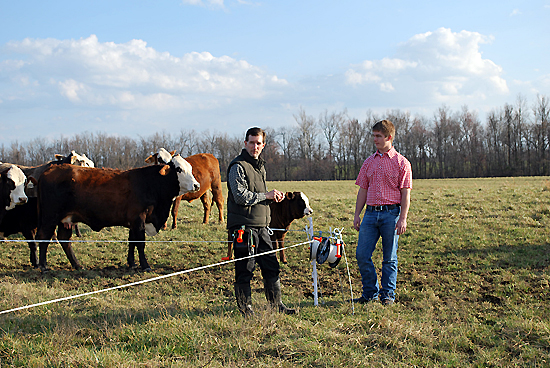Extension programs help producer graze cattle through winter
Extension programs help producer graze cattle through winter

Feeding hay to cattle throughout the winter has been a longstanding practice among Kentucky producers. Many could not fathom what it would be like to feed little or no hay in December, January and February. But it’s a reality for one Murray producer thanks to the practices he learned through University of Kentucky Cooperative Extension Service programs.
“In Kentucky, we historically have had a continuous grazing program,” said Garry Lacefield, UK extension forage specialist. “The changes have come about because of better fencing, better watering systems and the knowledge that if we do a better job of controlling our grazing management systems we can do a lot better job using more pasture in a higher quality state over more days of the year.”
Greg Reynolds attended the 2010 Kentucky Grazing School at UK Research and Education Center in Princeton. At the school, Lacefield taught Reynolds about extending the grazing season by stockpiling tall fescue and rotational- and strip-grazing cattle.
“Extension programs at the University of Kentucky are absolutely fantastic,” Reynolds said. “I went through that two-day program and learned a tremendous amount of information that was very practical and that I could bring home and actually put to use.”
This winter, he has fed a total of 98 square bales of hay for 19 days to his 20-head of Braford cows, which are a mix of Brahman and Hereford. However, he was prepared to feed for 120 days and had 1,300 square bales stored in the barn.
In the winter, the cattle grazed stockpiled tall fescue in a two-acre strip sectioned off with electric fencing. Each week, Reynolds and his son Jacob allowed the cattle to access another two-acre plot of fresh grass.
“Because we had them in such a small area, they didn’t trample the forage,” Reynolds said. “They were able to utilize a very, very large percentage of the forage. I wouldn’t say a 100 percent of it was utilized but definitely in the 80s.”
In the summer, these plots are increased to six acres for his rotational grazing program. He has a total of 11 grazing plots, so each section gets 10 weeks of rest after the cattle graze. Reynolds said they came up with the plot sizes and numbers on a trial-and-error basis and these numbers would be different for each operation based on their number of cattle and acreage. Reynolds feels that he could handle 20 more cow/calf pairs under his current grazing system.
To further enhance his operation, Reynolds attended UK’s Master Cattleman program and received advice from Roy Burris, UK extension beef specialist and Kevin Laurent, UK extension associate for beef and swine.
Reynolds said the grazing system takes little time to maintain once it’s in place, which is beneficial to him, as he has a full-time, off-farm job too.
“It only takes about an hour once a week to put up additional posts, string new temporary fencing and then take down the previous fencing and remove those other posts,” Reynolds said.
Lacefield agrees that implementing a grazing system is something every producer can do to improve the bottom line. Separate studies in Missouri and Illinois compared the cost of stored feed in the winter to other forms of grazing management. In both studies, stored feed had the highest cost per cow per day.
“Getting into a grazing system is not complicated or expensive, but it does require some planning,” he said.
In addition, Reynolds seeded red clover and orchardgrass into his tall fescue pastures to mitigate the effects of the tall fescue endophyte found in many tall fescue stands in the state. The endophyte can cause disorders in grazing animals. The clover makes the pasture more palatable and adds nutrients to the animal’s diet. Plus, as a legume, it removes nitrogen from the air and adds it to the soil, which in turn fertilizes the fescue.
Reynolds is also establishing an area of warm-season grasses the cattle can graze in the summer months when tall fescue, a cool-season grass, is at its worst. This was another practice he learned at the grazing school.
He’s fenced his cattle away from the ponds where possible and has worked with the local soil and water conservation district to install a gravity flow tank that allows the cattle to drink the pond water without contaminating their water source.
Two Kentucky Grazing Schools are planned this year. The first is April 10-11 at the UK Research and Education Center in Princeton. The second is Sept. 11-12 at the Woodford County extension office. For more information, visit the UK Grazing website at http://www2.ca.uky.edu/grazer/.
Agricultural Economics Extension

